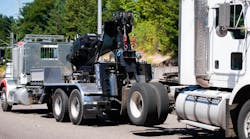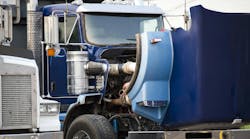Maintenance takes priority
Demands for lower maintenance costs and aerodynamic styling are behind most of the recent changes in heavy-duty air filters. Filters that last longer, while still maintaining their efficiency, help reduce maintenance costs. To meet the demand for more aerodynamic vehicles, filter makers face the challenge of designing smaller units that will take up less space under the hood, yet still provide long life and maximum capacity.
In addition to traditional axial-seal filters, many filter makers offer radial-seal units, which can be changed more quickly and feature a seal design that enables them to do a better job of keeping dirt out.
The radial seal filter from Baldwin uses gaskets made from a special nitrile rubber compound that holds up even under extreme temperatures, changes in restriction, and vibration. The flexibility of the seal's outer edges makes the unit relatively easy to install and remove. Donaldson's radial-seal filter uses "plastic-over-steel" construction, which means greater resistance to corrosion and chemicals, lighter weight, and the ability to withstand low temperatures. Fleetguard/Nelson's line of radial-seal filters includes the Magnum RS series, designed especially for severe-service environments. Radial-seal filters from Wix feature silicone gaskets that are said to maintain a constant leak proof seal throughout the life of the filters.
Most filters on the market today have cellulose (paper) media, although synthetic media are also available. According to Fleetguard/Nelson, in addition to a cost advantage, cellulose media often have higher initial efficiency performance. Synthetic media, on the other hand, have very high capacity and the material properties can be manipulated to provide the efficiency needed. Racor, for example, offers a line of filters made with synthetic media that are water-repelling, thus eliminating problems such as icing and corrosion.
After you've selected the air filters that are best for your application, determining when to change them is probably the most important decision you can make. Doing it right can save you time and money. As Luber-Finer points out, since the filter's job is to protect the engine from contaminants, if it's not working properly serious damage can result, as well as lower fuel mileage.
But if you change air filters too frequently, not only will you spend more time and money on maintenance than necessary, you'll also run the risk of not using them when they're most efficient. Air filters are not at their peak efficiency when they're brand new; efficiency actually increases after they've been in use a while.
Typically, engine manufacturers provide guidelines for how often air filters should be changed. This is usually determined by the maximum "allowable" restriction, that is, the amount of restriction the engine can tolerate without loss of performance.
Donaldson recommends a water manometer as the most accurate way to determine maximum restriction. But since many users don't have access to manometers, filter manufacturers generally agree that the most practical yet reliable way to measure restriction is to use a restriction gauge that's mounted on the vehicle.
In line with the trend to smarter vehicles, Fleetguard/Nelson says that the next generation of products is likely to integrate these restriction monitoring systems into "a complete engine-monitoring package...that will increase the operators' ability to know the status of their vehicle systems."
Seeing is not believing Filter makers warn against replacing air filters based on length of time, number of miles, or how dirty they look. As Baldwin points out, a filter can look very dirty and still have a lot of life left. By the same token, it can look relatively clean, yet actually have very fine contaminants that are blocking all the pores of the filter media and thus preventing the right amount of air from passing through. With air filters, seeing is not believing.
The problem with using visual observation is that it inevitably leads to over-servicing. And this is one case where giving a component too much attention is likely to do more harm than good.
The bottom line is that the optimum time for changing air filters is when they start to lose their efficiency - not before, not after. The further away you are from this point when you change the filters, the more time and money you'll lose. Keeping on top of this "will definitely give you the best return on the dollars invested in air filters," notes Wix.
While it may be tempting to clean air filters rather than change them, this is generally not a good idea. Banging on the side of the housing can send dirt into other components or even bend the end caps so it no longer fits correctly. And if you try to shake or blow on the filter itself, you can actually create holes that will greatly reduce its efficiency.


